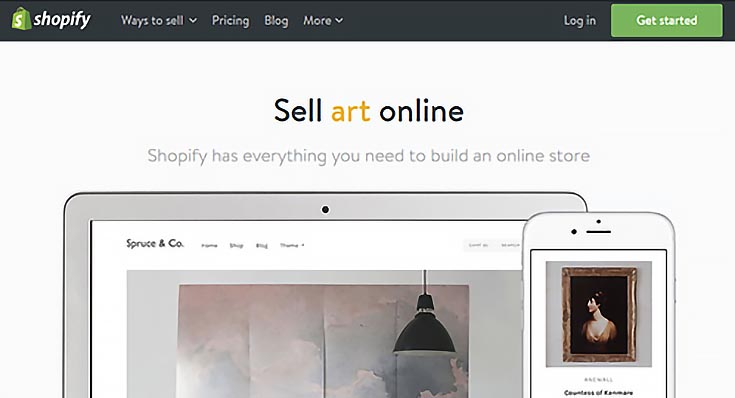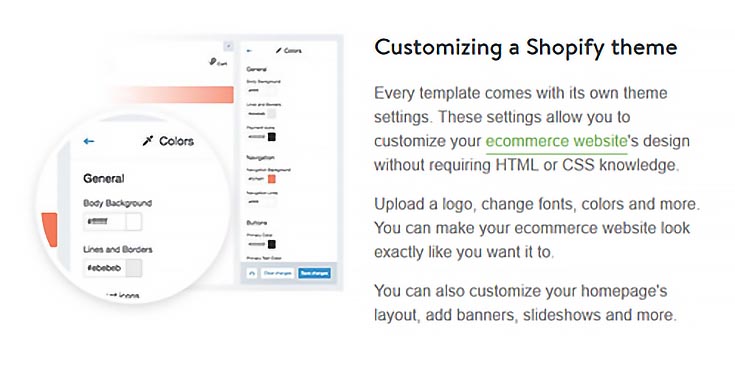Last month, along with group of about 30 other EmptyEasel artists, I launched a new online gallery for contemporary art.
I chose to use Shopify for this project (for all the reasons I’ll explain below) and throughout the process of setting up our online gallery, I realized that other artists would probably be interested in using Shopify as well.
Keep in mind, everything you read here is entirely my own opinion, based on my own experiences. If you’re like me, then I guarantee Shopify will be a good fit. . . but hey, maybe we’re just very different people! :)
I should also mention that I signed up as a Shopify affiliate recently, so if you decide to join through one of the links below, part of your purchase will come back to help support EE. However, you definitely shouldn’t feel compelled to do that.
OK, ready to dive in?? Here are 8 reasons why you might want to consider Shopify for your online art gallery:
1. You get access to a community of experts
If you’ve ever used WordPress (just to give one example) you know what having access to a really smart community feels like. I love WordPress for the same reason I love Shopify—when I had a question, or was trying to do something with the gallery, I could search Google for an answer, and LITERALLY, every single time, I found a Shopify discussion online that helped solve my problem.
You could even post a question in the Shopify forums yourself—I never had to, but if you did, you’d find Shopify Experts, fellow store owners, and even Shopify staff all chiming in to help answer.
This is extra important because of my next point:
2. Shopify is highly customizable. . . with code
I know how to write code, at least a little bit.
It’s not my main skill-set (originally I was a graphic designer and oil painter) but a few years back I began learning about HTML, PHP, and those other scary-sounding programming languages. Which, honestly, aren’t that hard if you enjoy that kind of thing. :)
Shopify uses themes that you can modify yourself, with just a little bit of code. In fact, in my opinion, Shopify is easier to program than WordPress has ever been. It runs on the same sort of code, but it’s simplified quite a bit, and as I mentioned before, there’s a TON of help even if you’re just starting out.
Plus, if you don’t want to program your own theme, that’s OK too! Read on.
3. There are hundreds of ready-made themes available
Shopify has tons of themes available. You can find any number of gorgeous themes that will probably work for your art gallery without any additional programming needed. Many of them allow customization of colors, fonts, image sizes, etc, all right from your Shopify account, without the need to learn programming.
If none of them strike your fancy, you can always hire a Shopify Expert to either modify an existing theme, or create anything else you might need for your art gallery.
So you really don’t need to get your hands dirty after all. :)
Sure, the themes (and programmers, if you hire them) cost money, but they’re definitely worth it. Even though I felt confident about my coding skills, I still started with a paid theme for NUMA, and then modified it rather than building my own from scratch. It cost $140 and it was worth every penny.
4. The apps are a nice bonus, too
Some of the apps are paid, but many are free, which sweetens the deal quite a bit.
For NUMA, I use apps for filtering the artwork (paid) as well as a MailChimp app (free) and a few others, too The MailChimp app is fantastic, because it makes it simple for people to sign up for your mailing list—which, as you’ll recall, is one of the best ways that an artist can start making recurring sales.
5. Shopify also offers secure credit card transactions
If you’re looking to sell art online, this is a biggie. By now, most art website providers offer support for credit card sales, and trust me, you need it! How else is anyone going to purchase your art? Credit cards are a MUST, and since Shopify is an all-purpose e-commerce solution, it’s actually something they’re very good at.
In fact, I think it only took about 5 minutes for me to get NUMA set up for credit card purchases; it was that easy. But that’s not all. . . not only can you accept credit cards online, with Shopify, you can also do it in person:
6. Need point of sale support? They got it.
Just like those “square” credit card swipers you see at coffee shops and farmer’s markets, Shopify has a small device that plugs into your smartphone or tablet and makes in-person sales a breeze.
Anytime you’re selling art at an art fair, you’ll want to able to accept credit cards. With Shopify, this device is included in their Basic store plan.
NOTE: In fact, you don’t even need to sign up for an online store to get their point of sale device and start accepting credit cards in person. Their $9/month plan is made for selling this way.
7. You can “pause” your gallery for a lower rate
Why is this important? Well, let’s go back to those art fairs. Typically, they’re seasonal, right?
Let’s say you want to set up a website and get Shopify’s credit card device for the summer months. With it, you sell art at all your local (and not-so-local) art fairs. You meet a lot of people, hand out your business cards, make some sales—and when the season is over, you can downgrade your account until next year.
Or, you can keep your website art gallery up for a few more months in case anyone you met decides to go online and make a purchase.
Either way, they give you a ton of control over your gallery, which makes the cost much more manageable.
8. Speaking of cost, Shopify also has a free trial
I know, I know. . . everyone’s got a free trial. It’s worth mentioning though. And you won’t have to enter your own credit card unless you actually plan to join as a paying member. You can sign up here for free, play around with your gallery, and just see if Shopify might work for you.
So is Shopify perfect for artists?
No, not at all. I think it has a lot more going for it than against it, but here are a few ways it’s not QUITE as good as a dedicated art website host:
1. It’s not specifically set up for artwork
Don’t get me wrong, Shopify definitely still works (check out NUMA and see for yourself) but if you log into your Shopify store and start creating new “products” you’ll notice that a few things aren’t quite as intuitive as they could be—for artists, anyway.
For one, there’s no default setting for entering your artwork dimensions. You can add that information in the description, of course, but if you want to show that information anywhere else, it’s not readily available.
And, you’ll notice that all the default settings they DO have are geared towards mass-produced products. They’re very capable of showing “how many items are left” or offering “free shipping when you purchase 2 or more” but those things don’t really help artists as much as they do other kinds of store owners.
2. They’re not QUITE as good at SEO as they could be
Maybe this is nitpicky. . . but because Shopify is set up as an online store, it tends to create a ton of duplicate content by accident. (And Google tends to hate duplicate content.)
For example, if you upload artwork and put that artwork in a “collection” (which is Shopify’s way of categorizing items in a store) you’ll be able to find that artwork on about 10 different pages of your site—10 pages, all with exactly the same content.
Yes, there are ways around this—sort of—but none of them are perfect. Still, I have hopes that Shopify will continue to improve in this regard. And, they DO do a lot of things right. I just tend to be overly-serious about SEO. :)
3. Last but not least. . . Shopify can be expensive
It all depends on what you need for your online art gallery. They have plans at $9, $29, $79, and $179 but that cheapest plan doesn’t include an online site (just the credit card reader for in-person sales, and the ability to create buy-now buttons to put on your blog, Facebook page, etc).
That might be enough for you, though, and in that case, it’s a pretty great deal at $9/mo. But if you need more features, or more control, it gets spendy fast. And that’s definitely a downside if you’re just starting out trying to sell your work.
If you’re more established, you have consistent sales, and you’re looking to give folks another way to purchase, then maybe Shopify would be a good choice. After all, you’re already selling offline—online is just another step up. But I’d caution against Shopify’s more expensive plans if you don’t already have a solid record of sales.
In the end, I know I looked around a LOT of options before making my decision, and I definitely encourage you to do the same. Ultimately, the community is what sold me on Shopify, and I can guarantee that it paid off.
I hope this all helps! Let me know if you have any questions about Shopify, or my experience using them to create an online art gallery—I’ll do my best to answer!
This post may contain affiliate links.



